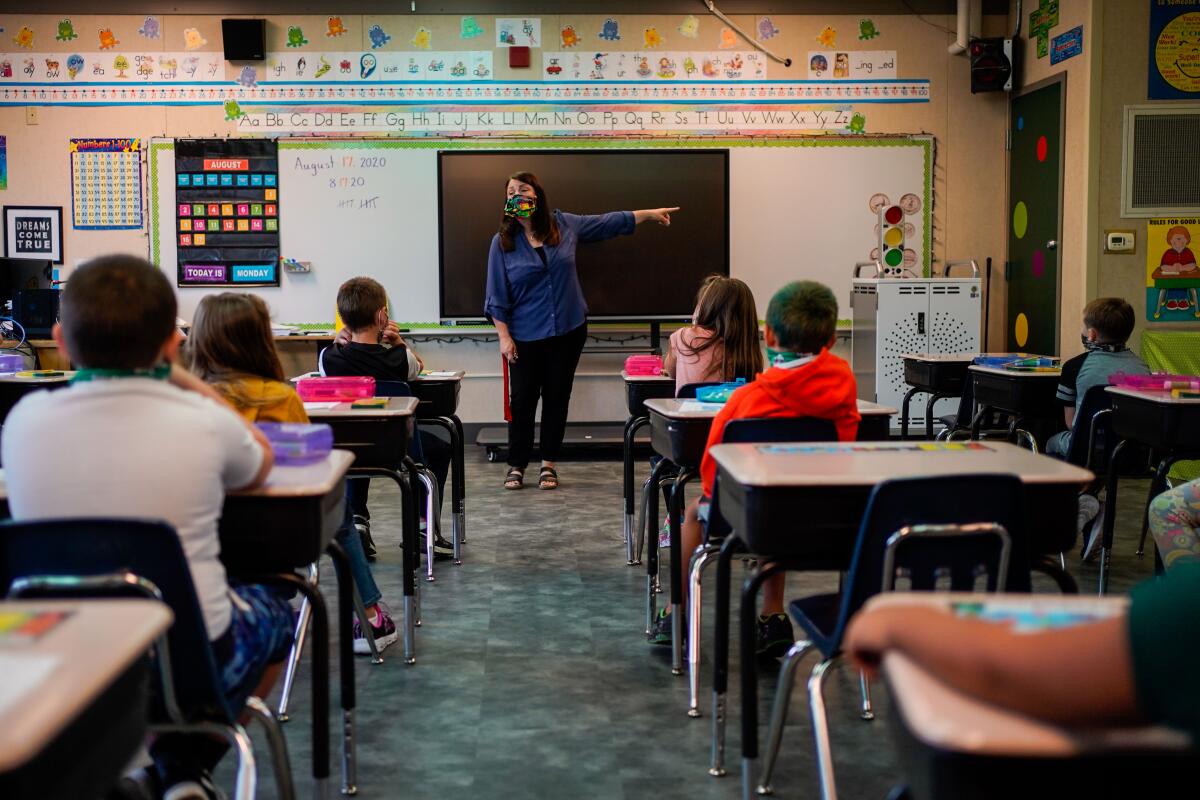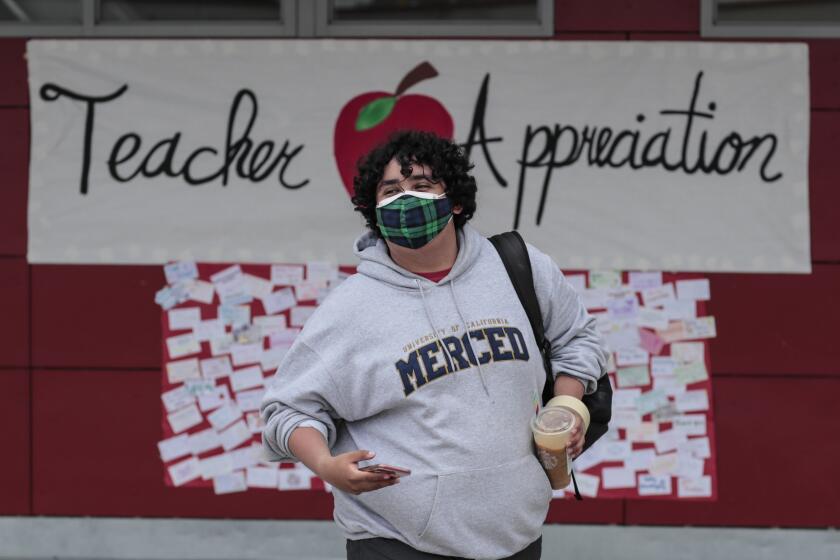Opinion: A record number of teachers are leaving the job. Here’s why I’m one of them

- Share via
I didn’t come to my L.A. school’s campus in August to set up my classroom, or spend my last days of summer mapping the upcoming curriculum. Instead, I became one of the record number of teachers not returning to the job.
Teacher turnover, long a problem in K-12 education, has reached a record high since the pandemic hit, with 10% of educators leaving their jobs in the 2021-22 school year. Turnover rates have slightly improved since, but teachers’ job satisfaction stands near a 50-year low, with a reported 55% considering leaving the profession earlier than they had planned.
Student behavior and low pay are among the top factors pushing educators out of the classroom. But I left teaching for another reason: I had children.
The Dodgers’ Teacher Appreciation Day event here in L.A. is a lovely gesture. My wife, a teacher, was too busy to attend. There’s a lesson there.
Of the nation’s 3.8 million teachers, close to half have children living at home. Yet teaching was never meant to be a sustainable career for a parent. In fact, it was designed to be the opposite.
In the 1830s and ’40s, education reformer Catharine Beecher (sister to the author Harriet Beecher Stowe and the preacher Henry Ward Beecher) popularized the idea of teaching as the female equivalent of ministry. Instrumental in feminizing the occupation, Beecher argued that pious young women should be the ones to do the moral work of teaching — in no small part because they provided cheap labor. In Beecher’s vision, teaching wasn’t so much a profession as a calling.
There was no room in this vision for marriage or motherhood. In fact, marriage bans were common in education through the 1950s. At the start of World War II, 87% of school boards would not hire a married woman and 70% would not retain female teachers if they got married. Teacher marriage bans were not officially outlawed until the Civil Rights Act passed in 1964.
The remnants of this history are still evident in the structure of the job. A 2022 report by the National Council on Teacher Quality found that only 18% of the nation’s school districts offer some form of paid parental leave. Teachers, who don’t always qualify for state disability or pay during leave through the Family and Medical Leave Act, are instead expected to exhaust sick days, pay for their own substitutes, return to work before they’re fully healed or time our births with summer vacation. As recently as 2019, Gov. Gavin Newsom vetoed a California bill that would have ensured six weeks of paid maternity leave for the state’s teachers.
I feel compelled to confess. That belly dancer in my 9th grade history class in 1982 at my L.A. magnet? I hired her. My bad.
Beyond paid leave, the inflexible structure of teachers’ hours makes it difficult to care for our own children. Yes, there are the long, glorious summers off, which relieve teacher-parents of the stress and expense of the summer camp scramble. But the dictated working hours of the school day during the rest of the year often conflict with their own children’s drop-offs and pick-ups, parent-teacher conferences, back-to-school nights, PTA meetings and other school events.
Caring for a child with special needs made this inflexibility even harder for me to navigate. My daughter was born with a rare genetic disorder and attends weekly medical therapies as well as periodic visits with a half dozen specialists. Balancing the absences these appointments required with the needs of my students and the demands of creating plans for substitutes quickly became unmanageable. And answering doctors’ frequent phone calls posed a logistical challenge in the classroom.
The work didn’t stop at the end of the school day. American teachers work seven hours per week more than adults in other professions, and 15 hours per week beyond their contracted, paid hours, according to RAND’s 2023 State of the American Teacher Survey. At LAUSD, I received one paid hour for planning and grading two different courses that together were taken by nearly 150 students. While this contract was typical, the paid time it allotted wasn’t adequate to complete the work, which I would end up bringing home.
A new L.A. Unified School District rule banning cellphones in classrooms begins in January. It will improve the learning environment and social interactions.
I coped by working through my lunch break, showing movies to students so that I could grade and staying up long after my daughter had gone to bed to plan lessons. I wasn’t just expected to work this unpaid overtime. The practice is codified into law. The Fair Labor Standards Act of 1938 exempted teachers from overtime pay and still stands as law today.
The teaching profession, and the American education system as a whole, is dependent on this kind of unpaid labor. In a workforce that is 77% female, that work is primarily done by women, just as American parenting, similarly lacking in structural support, relies on women. It’s 2024: Teaching should be structured to allow parents to meet the needs of their families, without sacrificing their students’ education — or themselves.
To start, the U.S. should enact paid family leave for all educators and end teachers’ Fair Labor Standards exemption. Some schools in Idaho and Texas have piloted school-sponsored child-care programs to help retain teachers; more such programs should be developed. And in the European Union, legislation has passed that gives all working parents of kids up to 8 years old the right to request flexible work arrangements, which can mean reduced or flexible hours, among other things. The U.S. needs to institute something similar.
Accommodations like these will not only support and retain teacher-parents but also will make the profession more attractive and sustainable for all teachers. They could even lure me back to the classroom and to a profession I loved — just not more than I love my own children.
Lauren Quinn is a former high school English teacher. She writes the newsletter Leaving Teaching.
More to Read
A cure for the common opinion
Get thought-provoking perspectives with our weekly newsletter.
You may occasionally receive promotional content from the Los Angeles Times.












